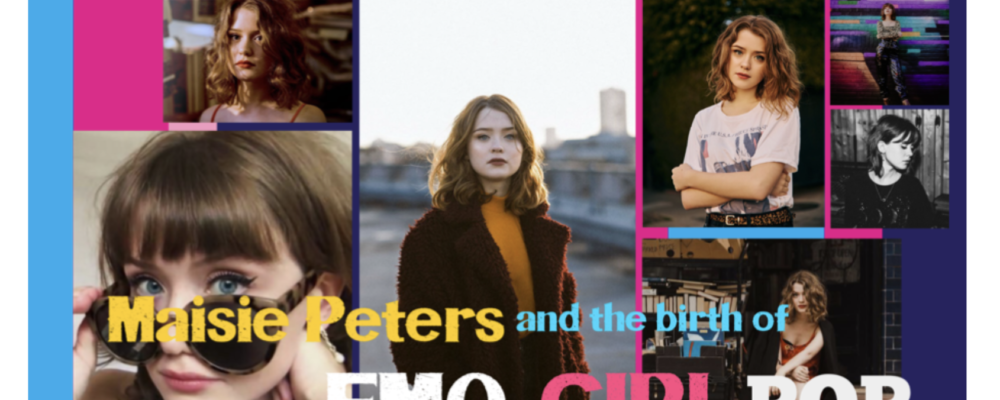You’ve heard of Emo-Pop, but the chances you’ve heard of Emo-Girl-Pop is highly unlikely, unless you’ve heard of singer-songwriter Maisie Peters. Sitting in a Zoom call amongst a handful of her dedicated fans, the twenty year old from Brighton dubbed as the “First Lady of Emo-Girl-Pop” answers the questions from the eager faced (mostly female) fans with the mannerisms of a teenage girl at a slumber party.
 Much like the audience of Emo-Pop, Maisie Peters has gained a loyal following from a younger audience that relate to her lyrics about boys, relationships, and the problems that often occur when the two are combined. Yet, one can’t help but shake the thought that her style bears uncanny resemblance to Taylor Swift’s songs from her earlier years; too upbeat, intimate, and innocent to be categorized as Emo-Pop, a different energy entirely when one compares Maisie Peters to Emo-Pop artists such as Fall Out Boy or Panic at the Disco. Her silvery and hushed ballad type verses, bouncy and spirited mid-vocal range choruses is uncharacteristic of the angst that is found in the upper-register intensity and supercharged driving guitar rhythm of Emo-Pop.
Much like the audience of Emo-Pop, Maisie Peters has gained a loyal following from a younger audience that relate to her lyrics about boys, relationships, and the problems that often occur when the two are combined. Yet, one can’t help but shake the thought that her style bears uncanny resemblance to Taylor Swift’s songs from her earlier years; too upbeat, intimate, and innocent to be categorized as Emo-Pop, a different energy entirely when one compares Maisie Peters to Emo-Pop artists such as Fall Out Boy or Panic at the Disco. Her silvery and hushed ballad type verses, bouncy and spirited mid-vocal range choruses is uncharacteristic of the angst that is found in the upper-register intensity and supercharged driving guitar rhythm of Emo-Pop.
If it isn’t Emo-Pop, what is Emo-Girl-Pop? Her distinct vocal and recitative type of lyric treatment gives it a distinct flavor, but in terms of chord structure and instrumentation, it seems very similar to the artists her compositions were inspired by; sentimental ballad and narrative pop music. One may even assume the word “Emo” has been disassociated with the distinct style of punk and its subculture, having been re-defined as its slang term, meaning “sad” or “emotional”, which may mean that Emo-Girl-Pop could be understood as “sad girl songs”. As she is known to many as the pioneer of a new genre that she created, some of us are left to wonder whether if artists can form new genres based on how we redefine terms even if their music can be categorized under an existing genre.
In an interview with FaceCulture in 2019, she sheds light on who inspires her own musical style.
On her narrative style…
FaceCulture: “Did you gravitate towards a lot of artists who have that narrative style of songwriting?”
Maisie Peters: “Definitely, A hundred percent I think to this day, all of my favorite artists, all my favorite songs are artists that are really narrative driven, that tell stories…
On her favorite artists…
FaceCulture: “Can you just name [her favorite artists] one or two?”
Maisie Peters: “Yes of course… I grew up on Taylor Swift and Lily Allen and Sarah Barrellis and Ingrid Michaelson, but then equally I love Kanye West, I loved Frank Ocean… even sort of very old songs, like jazz pieces…
On her musical style…
FaceCulture: So in that sense, would you say you’re still figuring out your musical identity? Or is it… an ongoing process?
Maisie Peters: For sure it’s always an ongoing process, I think I do, I sort of stumbled across it, it was never… I never felt that I really had to search cuz I’ve been writing for so long…
Sure enough, as one listens to the music of Maisie Peters, it is clear that her inspirations have shaped her musical style. Many of her song titles bears close resemblance to works released by Lily Allen as well as the content of what the lyrics are singing about. Her music is distinctly unique when compared with the music of Taylor Swift, Lily Allen, Sarah Barrellis, and Ingrid Michaelson, but just as these artists are all distinctly unique from one another, they seem to fall under the same genre. Perhaps Maisie Peters has claimed her genre of “Emo-girl-pop” as a sort of brand or logo, and rather a radical push to start a new moment of Emo-Girl-Pop, a musical RFID that would be her own identifiable signature.
Contributed by Joseph Chung a writer from The Clive Davis Institute x Billboard MUSIC INDUSTRY ESSENTIALS program.

